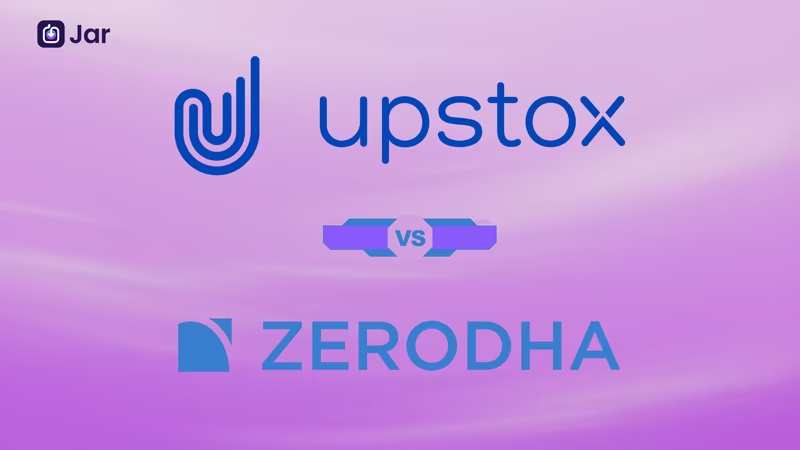Here is a side-by-side comprehensive comparison of all applicable charges for trading on Upstock and Zerodha, broken down by segment.
1. Equity Delivery
For buying and holding stocks for more than one day (long-term investment).
| Charge | Upstocks | Zerodha |
| Brokerage | ₹20 per executed order | ₹0 |
| STT (Securities Transaction Tax) | 0.1% on buy and sell | 0.10% |
| Exchange Transaction Charges | ₹3 | ₹3 |
| SEBI Turnover Charges | ₹10 /crore | ₹10 / crore |
| Stamp Duty | 0.015% | 0.02% |
| GST | 18% | 18% |
2. Equity Intraday
For buying and selling stocks on the same day.
| Charge | Upstocks | Zerodha |
| Brokerage | ₹20 or 0.1% of the order value, whichever is lower | ₹0 |
| STT (Securities Transaction Tax) | 0.025% on sell only | 0.10% |
| Exchange Transaction Charges | 0.00297% (NSE) | 0.00297% (NSE) |
| SEBI Turnover Charges | ₹10 / crore | ₹10 / crore |
| Stamp Duty | 0.003% | 0.02% |
| GST | 18% | 18% |
3. Equity Futures
An agreement to buy or sell a fixed quantity of stock/index at a predetermined price on a future date.
| Charge | Upstocks | Zerodha |
| Brokerage | ₹20 or 0.05% of the order value, whichever is lower | ₹0 |
| STT (Securities Transaction Tax) | 0.02% on sell side | 0.10% |
| Exchange Transaction Charges | 0.00297% (NSE) | 0.00297% (NSE) |
| SEBI Turnover Charges | ₹10 / crore | ₹10 / crore |
| Stamp Duty | 0.002% | 0.02% |
| GST | 18% | 18% |
4. Equity Options
Gives the buyer the right, but not the obligation, to buy or sell a stock/index at a specific price.
| Charge | Upstocks | Zerodha |
| Brokerage | Flat ₹20 per executed order | ₹0 |
| STT (Securities Transaction Tax) | 0.1% on sell side (on premium) | 0.10% |
| Exchange Transaction Charges | 0.00297% (NSE) | 0.00297% (NSE) |
| SEBI Turnover Charges | ₹10 / crore | ₹10 / crore |
| Stamp Duty | 0.003% | 0.02% |
| GST | 18% | 18% |
Upstox
Founded by the Kumar brothers, Ravi and Raghu Kumar, along with Shrinivas Viswanath and Kavitha Subramanian in 2009, Upstox has revolutionized retail investing by bringing accessibility to the masses through affordable, innovative tools.
Upstox achieved profitability in FY24, marking its second consecutive profitable year with ₹190 crore net profit (8x growth YoY).
Despite being venture-backed by Tiger Global, Kalaari Capital, and other investors, the company maintains a customer-first, innovation-driven approach.
Upstox transformed the industry with its proprietary platforms—Upstox Pro Web and Mobile—powered by advanced APIs and cloud-native architecture, setting it apart from traditional brokers.
Industry Overview
India's retail investing ecosystem saw active NSE clients grow from 40.8 million in FY24 to 49.2 million in FY25, marking a 21% increase.
Discount brokers like Groww, Zerodha, Angel One, and Upstox now control over 63% of the market share, with Upstox holding a 5.83% share and 2.89 million active users as of December 2024, with 85% of its customer base from Tier 2 and Tier 3 cities.
Zerodha
Founded by Kamath brothers Nikhil and Nithin Kamath in 2010, Zerodha has disrupted the retail investing industry by bringing a zero brokerage fees model.
Zerodha is the most profitable fintech platform in India. It remains bootstrapped, demonstrating its commitment to user trust and transparency.
Zerodha transformed the industry with their tools, like Kite and Coin, which today also set them apart from their competitors.
Industry Overview
India’s retail investing ecosystem saw active NSE clients grow from ~40.8 million in FY24 to 49.2 million in FY25, marking a 21% increase.
Discount brokers like Groww, Zerodha, Angel One, and Upstox now hold over 63% of the market share.
Check out our comprehensive deep dive into Groww Vs Zerodha
Brand Analysis
Financial Snapshot & Market Position
| Metric | Upstocks | Zerodha |
| Market Share | 5.83% | 16% (approx.) |
| Active User Base | 2.89 million (Dec 2024) | 7.89 million |
| YoY Change | 25% | 0.083 |
| Revenue | ₹1,310Cr | ₹9372 crore (YoY +37%) |
| Net Profit | ₹190 crore | ₹5,496 crore |
| Valuation and Last Funding Round | Venture-backed; $3.5 billion valuation (2022); Tiger Global is a major stakeholder | Bootstrapped: No external funding; ~$2 billion valuation |
| AUM (Mutual Funds) | Not disclosed (focused on brokerage) | ₹6,400 crore (in ETFs over 18 months) |
Brokerage & Fee Structures
While choosing a stockbroker, one of the most important things to consider is how much brokerage you'll pay.
Let’s compare Upstock and Zerodha, two popular discount brokers in India.
Zerodha offers ₹0 brokerage on equity delivery and charges a flat ₹20 per trade for other segments like intraday and F&O. On the other hand, Upstock charges ₹20 or 2.5% (whichever is lower), and the same for Intraday Trades.
| Transaction Type | Upstocks | Zerodha |
| Equity Delivery | ₹20 or 2.5% (whichever is lower) | ₹0 |
| Intraday Trades | ₹20 or 0.05% (whichever is lower) | ₹20 or 0.03% (lower) |
| F&O Trades | ₹20 or 0.05% (whichever is lower) | ₹20 or 0.03% |
| Demat Annual Fee | ₹150/year (First year free) | ₹300/year |
| Account Opening | ₹0 (Free) | ₹0 (Free) |
| Mutual Fund Investment Fee | ₹0 (No brokerage) | ₹0 brokerage charges |
| Commodity & Currency | Available - ₹20 or 0.05% per order (whichever is lower) | Available |
| Call & Trade | ₹88.50 (₹75 + 18% GST) per order | ₹50/order via phone |
| Physical Contract Note | Not specified | ₹20 |
| Auto Square-Off Charges | ₹88.50 (₹75 + 18% GST) per order | ₹50 per order |
Strategic Breakdown: Upstox vs Zerodha
| Strategic Factor | Upstocks | Zerodha |
| Market Entry Strategy | Entered in 2009 as a discount brokerage with zero-commission trading on equity delivery. | Entered in 2010 with a banger zero-brokerage model. |
| Pricing Strategy | Transparent, flat-fee pricing model; shifted to a pay-as-you-trade structure with zero AMC to ensure cost efficiency and consistency across user segments. | Transparent pricing; no gimmicks, focused on lowest trading cost efficiency. |
| Tech & Infra Strategy | Developed proprietary platforms, including Upstox Pro Web and Mobile for advanced traders; invested in high-frequency APIs and cloud-native architecture for scalability. | Developed in-house platforms (Kite, Console, Coin); APIs for advanced traders and fintech integrations. |
| Ecosystem Play | Growing ecosystem with real-time analytics tools, SmartLists for curated insights, UpNews for financial content, and API integrations for advanced traders and developers. | Lean ecosystem with strong integrations: Coin, Rainmatter, and analytics tools. |
| User Targeting Strategy | Initially focused on active traders, gradually expanded to reach Tier 2 and Tier 3 cities (85% of the user base); now targeting both retail investors and experienced traders seeking accessibility and affordability. | Focused on active, experienced traders and HNIs seeking low-cost, high-control platforms. |
| Monetization Model | Brokerage fees (flat ₹20 or percentage-based), margin lending with interest income, mutual fund distribution, insurance products, and fixed deposits. | Brokerage fees, margin lending, interest income, AMC, and ecosystem investments (e.g., Smallcase, Ditto). |
| Funding & Valuation | Venture-backed by Tiger Global, Ratan Tata, and Kalaari Capital; raised $60.25 million across 4 funding rounds; valued at $3 billion (2022); recently achieved profitability. | 100% bootstrapped (ESOPs around $1 billion) |
| Profitability Approach | Achieved profitability in FY24 with ₹190 crore net profit (8x jump from FY23); focused on sustainable growth and innovation-driven expansion. | Profitability has been their focus and has been profitable and sustainable from the early years. |
| Brand Personality | Positioned as an accessible, innovation-driven platform democratizing wealth creation, emphasizes simplicity, speed, and security with a strong focus on financial inclusion. | Positioned as a trusted, serious, and transparent platform with high credibility. |
| Growth & Partnerships | Strategic IPL partnerships (Official Partner with ₹45 crore annual premium); digital marketing campaigns targeting Gen Z and millennials; organic growth through community engagement and educational content (UpNews, learning initiatives). | Organic growth with strategic tech investments and community engagement (Z-Connect, Varsity). |
User Experience & Target Audience: Upstox vs Zerodha
When it comes to user interface and overall experience, the two platforms are poles apart.
Upstock has a modern and intuitive and a mobile first design approach. The onboarding is simple and easy, for first-time users and retail traders from tier 2 or 3 cities, as it has a clean dashboard and guided workflows. The platform emphasisis simplicity, which akes financial tools less overwhelming for beginners.
Zerodha, on the other hand, packs power and depth. Its flagship platform, Kite, is loaded with customizable widgets, charting tools, and advanced analytics. This makes it a go-to choice for active traders and seasoned investors who want complete control and flexibility.
Download the Jar app and save money in 24k digital gold starting at ₹10/day.
FAQ
Which is better, Zerodha or Upstox?
Zerodha and Upstox are renowned online discount brokers. Upstocks is better than Zerodha in the following way: Advanced traders can use Dartstock, NEST Trader, and Fox Trader on Upstox. Kite is Zerodha's only trading platform.
What is the disadvantage of Upstox?
Upstock charges a brokerage fee of Rs 20 per trade for stock deliveries. While other brokers offer stock deliveries without brokerage fees. Upstock also dosen’t offer unlimited monthly trading plans. Margin funding isn't available for delivery trades.










